Not all RVs are a great choice for navigating tight city streets, small parking lots, or even certain areas in national parks. This is why many Class A RV owners choose to tow a smaller vehicle (often referred to as a “dinghy” or a “towed car” or just a “toad”) behind their RV. If you want to flat-tow a car when you travel, you’ll need an RV tow bar.
Keep in mind that while flat-towing (also known as 4-down towing… as in all four wheels on the ground) is the ideal towing method for many RVers, it’s not the right choice for everyone and isn’t even possible with many cars. You can see information about all of the common options for bringing a car along with you in this article: Everything You Need to Know About Towing a Car Behind an RV
Let’s take a look at what an RV tow bar is, how it works, and how to connect and disconnect one.
TO SEE EXACTLY HOW TO CONNECT AND DISCONNECT, CHECK OUT THE VIDEO ABOVE!
- 1) What Are RV Tow Bars?
- 2) How Do RV Tow Bars Work?
- 3) What You Need to Flat Tow a Car
-
4)
How to Hook Up Your Car to Your RV Tow Bar
- 4.1) Park on a Level Surface Whenever Possible
- 4.2) Pull Up Behind the RV, as Straight as Possible with the RV Tow Bar
- 4.3) Attach and Secure the RV Tow Bar Arms
- 4.4) Attach Safety Cables and Breakway Cable
- 4.5) Plug in the Wiring Harness
- 4.6) Make Sure the RV Tow Bar Latches are Engaged
- 4.7) Prepare the Tow Car for Towing
- 5) RV Tow Bar Binding: What is it?
- 6) How to Prevent RV Tow Bar Binding
- 7) Enjoy the Convenience of RV Tow Bars
What Are RV Tow Bars?
An RV tow bar is a critical piece of any plan to flat-tow a vehicle behind an RV because it’s what connects the front of the toad to the rear of the RV.
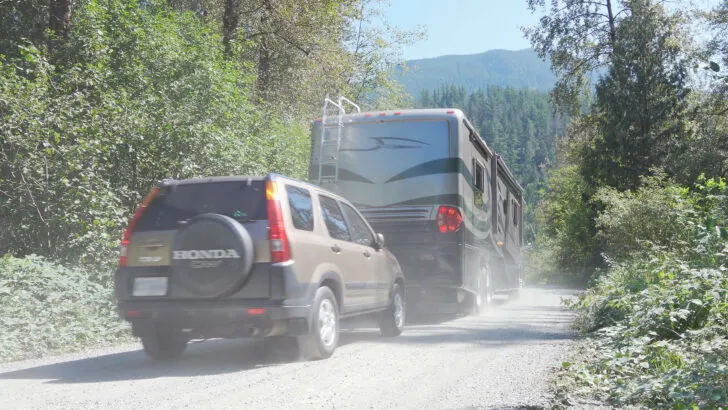
We’ve flat-towed our 2003 Honda CR-V behind our Class A RV for nearly two decades. Flat-towing leaves all four wheels of your tow vehicle on the ground.
“Flat-towing” is a term used to describe towing a vehicle with all four wheels on the ground. It’s an increasingly popular way to pull a car behind an RV, and the specialized equipment involved in the process is time-tested and dependable.
The best long-term advantage to an RV tow bar? Once installed, it offers the simplest, fastest way to hook and unhook a vehicle to the back of your RV for towing. And it also takes up virtually no additional space at the campsite.
How Do RV Tow Bars Work?
RV tow bars come in various designs, but all incorporate a steel or aluminum bar that connects to the back of the RV’s frame, typically attaching to a standard 2″ trailer hitch receiver. That type of receiver is very common on RVs, but can easily be added as an aftermarket add-on if your RV doesn’t already have one. That’s one end of the system.
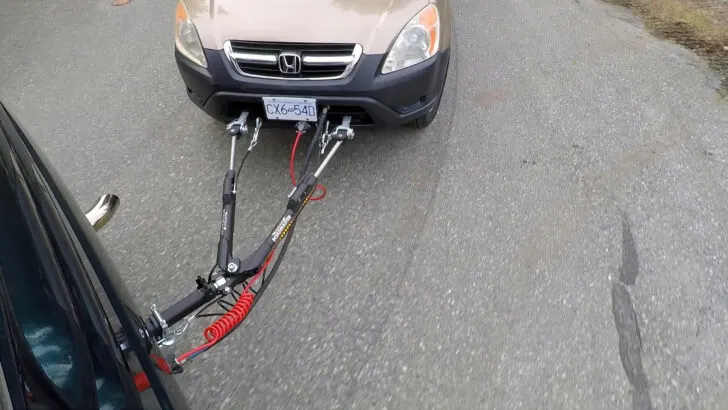
As the RV tows the dinghy, the arms pivot when rounding corners, similar to towing a boat or utility trailer.
From there, two pivoting arms link to the front of the vehicle you’re towing. Since cars don’t come from the factory with tow bar connection points on the front, a special “base plate” needs to be installed into the front of the car. Safety cables, a system to control the car’s brakes, and connections to the car’s lighting complete the package.
The arms pivot as the RV goes around corners, allowing the toad to smoothly follow the RV like a trailer.
What You Need to Flat Tow a Car
As mentioned, the RV must have a hitch receiver in the rear, and the towed vehicle requires a base plate up front to allow the tow bar to connect to it.
The tow bar itself sits between the dinghy vehicle and the RV. One end mounts to the RV’s trailer hitch receiver, and the other end attaches to the dinghy’s base plate.
Also important to the setup are safety or “breakaway” cables that criss-cross under the tow bar. These ensure that the tow bar and the toad remain contained even if it detaches from the RV somehow, providing you with a secure backup connection. When a quality tow bar is installed and used correctly, a breakaway is very unlikely.
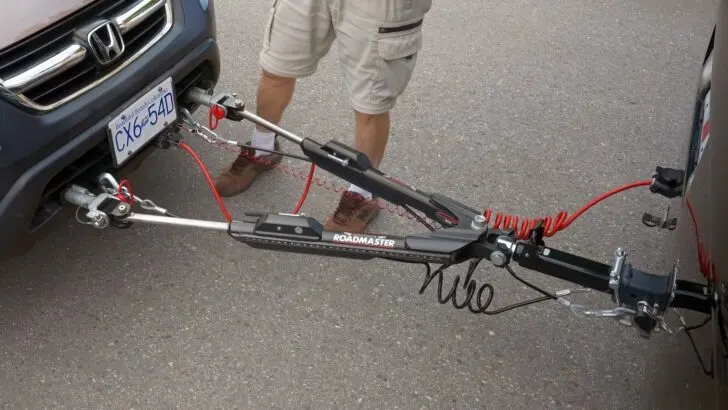
Here you see our RV tow bar attached, along with the safety cables and the wiring for the lighting and supplemental braking system.
And finally, you’ll need the appropriate wiring and supplemental braking system. This safety feature will illuminate the toad’s brake/tail/turn lights in tandem with the RV’s lights. Our system also includes a special cable that will automatically activate the car’s brakes in the unlikely event of a breakaway.
All of this equipment must align properly with the towing capacity of your RV’s hitch receiver and the GCWR (Gross Combined Weight Rating), which is the maximum weight of your entire RV, the weight of the vehicle you’re towing, and everything contained in both vehicles. The GCWR can be found on a placard, usually located near the driver’s seat.
How to Hook Up Your Car to Your RV Tow Bar
With the right equipment in hand, you’re ready to hook up your vehicle. Here’s what you need to know:
Park on a Level Surface Whenever Possible
The easiest place to hook up a tow bar is on a level surface. Park your RV in the most level location available, leaving plenty of space behind the RV for your dinghy vehicle to pull up behind it.
Pull Up Behind the RV, as Straight as Possible with the RV Tow Bar
When you drive your toad to line it up behind your RV, be sure to situate the car as straight as possible behind the RV. Once the two are in a straight line, pull up close enough for the tow bar to reach the front of the car, but not so close that there isn’t room to connect it. Until you get some practice, having a helper guide you can save a lot of trial and error. Once lined up, put your toad vehicle in park, and engage the emergency brake.
Attach and Secure the RV Tow Bar Arms
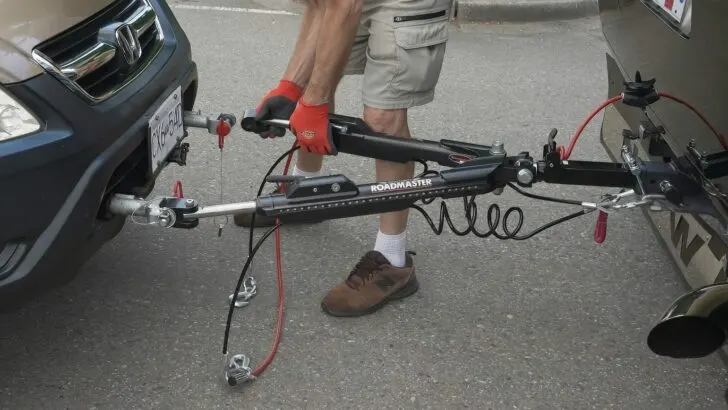
Here we secure an arm of the tow bar to one of the two connectors on our toad’s base plate.
Connect the tow bar arms to the attachment points on the base plate at the front of your toad, securing each arm to the appropriate connection on each side. Always insert the pins from the inside facing out. That’s because the geometry of the towbar will try to work the pins outward while the vehicle is in motion. So, in the unlikely event a locking clip comes loose (or you accidentally forget to install it when connecting the car), the pin won’t fall out. If this tip isn’t clear, watch the video above for a visual explanation of this important safety tip.
Attach Safety Cables and Breakway Cable
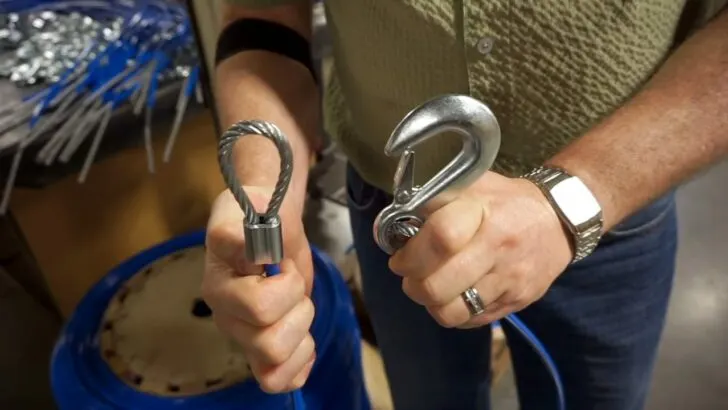
Safety cables are an essential piece of any towing package as they prevent the towed vehicle from completely detaching from the RV in the event of a failure.
Connect the safety cables from the RV to the toad’s base plate connections. Criss-cross the cables once under the tow bar, and make sure they’re not dragging on the ground. Also, be sure to connect your breakaway cable, which automatically activates the brakes in the unlikely event the car separates from the tow bar or the tow bar separates from the RV. Any other connections should be attached as well, such as an air line if you have an air-activated braking system that connects to the RV air system.
Plug in the Wiring Harness
Connect the electrical umbilical that carries the signals for lighting and braking functions, which should synchronize the brake, tail, and turn signal lights of both vehicles. Depending on your setup, this may also trigger the auxiliary braking system in the toad whenever the brakes are applied in the RV.
As part of your overall pre-trip inspection, always test the lights before you drive away.
Make Sure the RV Tow Bar Latches are Engaged
Back your toad up, or pull your RV forward, very slowly to establish that at least one of the two tow bar latches is locked. If you’re lined up perfectly, both arms may lock, but it’s only necessary to lock one. If both arms lock, that’s great, but if only one locks, be sure that when you’re ready to drive away in the RV, you start off slowly until the second arm locks. You’ll either feel it lock (a “bump” as you pull forward) or see it happen in your backup camera if you have one.
Prepare the Tow Car for Towing
The steps needed to ensure your towed car is properly prepared to be flat-towed will vary by year, make and model. Be sure you follow the specific instructions in your car’s owner’s manual.
Generally, you’ll want to ensure the car’s steering remains unlocked (often by inserting the key into the ignition and turning it to “ACC” and then back, and then leaving the key in the ignition) and that the wheels will turn freely. In many you’ll need to accomplish that by putting the transmission in Neutral… but in a step that seems to defy logic, some cars actually require putting the transmission into Park!!
Read your owner’s manual and confirm that your car is approved, and properly set up, for flat towing. Of course, the parking brake needs to be off in all towed vehicles.
RV Tow Bar Binding: What is it?
If you don’t have a non-binding tow bar, like our Roadmaster, tow bar binding can happen when trying to disconnect. It’s most common when the two vehicles aren’t perfectly straight or when parked on a downhill slope when you want to disconnect. The weight of the toad pressing toward the RV can make it very difficult, or nearly impossible, to release the RV tow bar latches.
How to Prevent RV Tow Bar Binding
To prevent binding, try to park on a level surface with the RV and toad as straight as possible. When that’s not practical, you can try putting the toad in reverse and pulling back hard against the tow bar while a helper tries to release the latches. We share some additional visual tips in the video above.
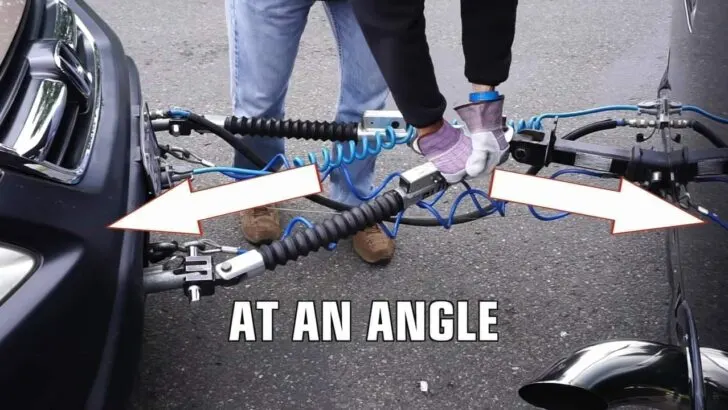
Tow bar binding can occur if you’re parked on a slope or at an angle.
You can also choose to use a non-binding tow bar like our Nighthawk, which comes with Roadmaster’s “Freedom Latches” (and rows of LED lights for added safety and visibility!) that prevent binding under virtually any condition. With this type of tow bar, you’re unlikely to encounter tow bar binding. Ever. Many Roadmaster tow bars use these same patented latches.
There’s even a special package you can get if you order a Nighthawk towbar direct from the Roadmaster factory.
Call Roadmaster at (800) 669-9690 to order your Nighthawk tow bar factory direct and tell them you want “The RVgeeks Package”. You'll receive a FREE Tow Bar Cover & Hitch...Show More
Call Roadmaster at (800) 669-9690 to order your Nighthawk tow bar factory direct and tell them you want “The RVgeeks Package”. You'll receive a FREE Tow Bar Cover & Hitch Receiver Lock to keep your new Nighthawk secure and looking great. Free Shipping is also included!
The Roadmaster Nighthawk is our favorite RV tow bar. The non-binding latches ensure you'll have an easy time disconnecting, no matter how the RV and tow car are positioned. Longer arms make connecting and disconnecting easier. And the LED lights along the arms improve safety and visibility when towing!
Check out our latest Nighthawk video here
Show LessEnjoy the Convenience of RV Tow Bars
An RV tow bar is a fantastic invention for RVers. It means you don’t have to break camp and drive a behemoth of a vehicle for a quick run to explore a national park, head out for a meal, or pick up groceries. And you don’t need to find room for a dolly or trailer at your campsite. Not to mention that there’s no faster way to connect or disconnect a toad (check out the end of our video above for a real-time demonstration with a timer running)!
Oh, and don’t worry… modern cars, with electronic odometers, don’t accumulate miles while being flat-towed since the car’s electronics aren’t powered up while it’s being towed! ????
With a tow bar and “dinghy” along, you’ll have the best of both worlds – a motorhome for living comfortably on the road, with small, convenient (more fuel efficient?) everyday transportation in tow. Perfect!
Geek Out with Us Every Week
Join our newsletter to learn about all things RV-related. Every week we offer free tips, tricks, product reviews, and more to our online community of RVers. Whether this is your first time on the road or you’re a seasoned expert, we’d love for you to geek out with us!


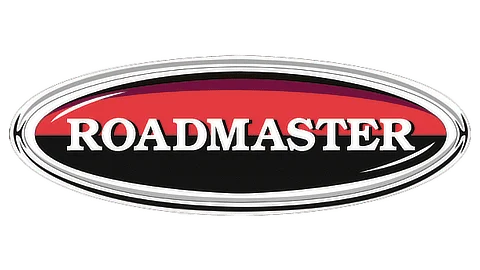
Penny
Sunday 13th of February 2022
Hi guys. Love your videos and articles. I learn so much. I just got a 2014 CRV set up by a RV retail shop for towing. They took the front bumper off and put it in the back seat. Did they take your bumper off your Honda CRV too?
TheRVgeeks
Tuesday 15th of February 2022
Hi Penny. We wanted to reply to your follow-up question here publicly, in case anyone else is seeing this, and can benefit from it. First off, kudos to the shop for including a part they removed from your car instead of just keeping it. We saw the installation instructions you provided, and re-confirmed them on the Blue Ox website, and are confident have the confusion on our part figured out. It all lies in the meaning of the word "bumper" vs "bumper cover." The bumper cover is the visible outer layer, which should be back in place on your car, and is what we thought you meant when you said the bumper was in the back seat. The "bumper" they're referring to is a part that is hidden under the bumper cover, and according to Blue Ox is to be left off once the base place is installed in its place. As long as your car looks normal, with the bumper cover back in place, you should be good to go, and can discard the part they left on your seat, as it's no longer needed (unless you plan to remove the base plate, which would be VERY unusual to do). Hope this helps!
TheRVgeeks
Sunday 13th of February 2022
Hi Penny! Thanks so much for the kind words. Always great to hear we've been helpful. We had our Honda baseplate installed when we first hit the road about 19 years ago, and we weren't there when the work was being done. But we do know that removal of the front bumper is required, so nothing unusual about that. The "putting it in the back seat" part we're not so sure about! LOL We hope you're not saying that they LEFT it there, because it's absolutely supposed to be re-installed once the baseplate is in place. We have friends with the same exact 2014 CR-V you have, and while the bumper comes off for installation, it goes back on as part of the job, and their car looks totally normal to the casual observer. Hope yours does, too.
Chris Patterson
Sunday 18th of July 2021
can a jeep dealer install all the things needed on a jeep grand Cherokee for dinghy towing? Or do I need to go to my tiffin dealer? Also, is the road master plug and play or do I need that installed also?
TheRVgeeks
Sunday 18th of July 2021
Hi Chris! The single biggest factor in using a tow bar is the installation of the base plate into the car being towed. Because that's a fairly specialized installation, it's not the type of thing that a car dealer, or even an RV dealer, would necessarily know how to do. The most common place to have it done is at a shop with experience getting RVs set up for towing, such as a shop that specializes in repairing RVs. Your Tiffin dealer may do those installations, so of course you should ask them. Some do, and some don't. But if they say they've never installed a base plate before, look elsewhere. Once the base plate, lighting and brake components are set up in your Jeep, the tow bar itself is the single easiest part of all, and it usually is basically plug-and-play. There's almost nothing involved in installing the bar itself into the back of the RV. But because it is so easy, it's probably best to have it done at the same time the base plate, brakes and lighting are being installed. That way the technician can check the operation of the entire system.
Shawn O’Brien
Wednesday 16th of June 2021
Interesting tip on installing the pins from the inside out. The Roadmaster Users Manual shows just the opposite, installing from the outside in, which is the way I’ve been doing it. Since I believe Roadmaster values your input, maybe you can get them to change their documentation. :-P Always learning something new from you guys. Thanks!!
TheRVgeeks
Wednesday 16th of June 2021
Hi Shawn. We were unaware that the manual has that information. We actually ran this by Roadmaster when planning the video, so we're going to check back in to see if they can shed any light on the situation. We'll be sure to update if needed, or ask them to! But we're pretty sure that if the manual specifies outside-in, it should be changed. Can you please let us know what model tow bar your user manual is for? Thanks!
Michael Montag
Wednesday 2nd of June 2021
Great video! I have a Nighthawk tow bar that attaches to a Blue Ox baseplate like the setup on your RV. Recently, I discovered the tow bar does not lock the toad to the RV even when using pin locks. The tabs are removable from the baseplate allowing your toad to be rolled away. When you overnight in a parking lot or are away from your rig for an extended period, do you lock your toad to the RV and if so, how?
TheRVgeeks
Wednesday 2nd of June 2021
Hi Michael! Thanks for adding this information to the discussion. When we had our original Blue Ox tow bar we figured out early on that rotating the attachment clips on the front of the car would leave them hanging on the tow bar, and separate the car from the RV. That's one of the reasons we never use padlocks on the car side of the tow bar. The other reasons are in case of fire, we want to be able to disconnect as quickly as possible, and also to make connecting and disconnecting that much simpler. We're also not especially worried about it for a couple of reasons. First, we generally travel in areas we feel pretty safe in (not that crime can't occur anywhere), and second, we do always keep the car locked when towing, or parking it connected to the RV. Also, whenever we're in any place overnight with the car connected, we removed the key from the ignition and re-lock the car, making it as secure as any other time we're parked anywhere in the car. To make sure we don't drive away in the morning without putting the key back in the ignition for towing, we clip it to the RV's keyring, so we can't start the RV without it being right there in our hand as a reminder.
Deborah Kerr
Monday 31st of May 2021
Thank you so much for the detailed instructions. We're considering my 2009 CRV awd as a toad for our 2008 Four Winds Siesta. I think it's do-able but need to find a weld shop to install the CRV base plate. We'll buy the Roadmaster Nighthawk if we go forward. It seemed very intimidating before this, but you showed every. single. detailed. step and now I feel like that is something we could actually handle! I need to watch someone do it first to learn it. ???? You are a top-notch teacher Peter!! ????
TheRVgeeks
Monday 31st of May 2021
Thanks so much, Deborah! Hard to go wrong with the Nighthawk. As far as the base plate goes, I don't think they usually require welding. Before you choose a shop, we'd suggest calling the Roadmaster factory at (800) 669-9690. They make base plates for just about every car that's ever been flat-towable. So they'll know exactly which base plate is required for an '09 CR-V, and how it gets installed. If it doesn't require welding, you'll likely be able to choose a different shop to do the job (the factory may very well be able to recommend a qualified installer in your area). Safe Travels!